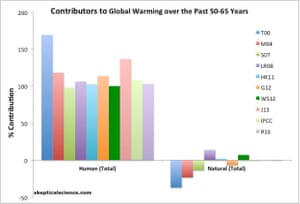Study: humans have caused all the global warming since 1950
Global warming attribution studies consistently find humans are responsible for all global warming over the past six decades.
 Steam rises from the cooling towers of the Ferrybridge power station on March 13, 2009 in Ferrybridge, Yorkshire, England. Photograph: Christopher Furlong/Getty Images
Steam rises from the cooling towers of the Ferrybridge power station on March 13, 2009 in Ferrybridge, Yorkshire, England. Photograph: Christopher Furlong/Getty ImagesDana Nuccitelli
Tuesday 19 April 2016 11.00 BSTLast modified on Tuesday 19 April 201611.01 BS
A new study published in Climate Dynamics has found that humans are responsible for virtually all of the observed global warming since the mid-20thcentury. It’s not a novel result – in fact, most global warming attribution studies have arrived at the same general result – but this study uses a new approach.

FacebookTwitterPinterest The percentage contribution to global warming over the past 50-65 years in two categories: human causes (left) and natural causes (right), from various peer-reviewed studies. The studies are Tett et al. 2000 (T00, dark blue), Meehl et al. 2004 (M04, red), Stone et al. 2007 (S07, green), Lean and Rind 2008 (LR08, purple), Huber and Knutti 2011 (HK11, light blue), Gillett et al. 2012 (G12, orange), Wigley and Santer 2012 (WG12, dark green), Jones et al. 2013 (J13, pink), IPCC AR5 (IPCC, light green), and Ribes et al. 2016 (R16, light purple). The numbers are best estimates from each study. Illustration: Dana Nuccitelli
Studies attempting to figure out the global warming contributions of various human and natural sources usually use a statistical approach known as ‘linear regression’. This approach assumes we know the pattern of warming that each source (forcing) will cause, but we don’t know how big the resulting warming will be. For example, we know that greenhouse gases cause more warming over land than water, the most in the Arctic, and more warming in response to rising atmospheric carbon dioxide levels.
As an example of this approach, this animated graphic shows what happens whena 2011 study by Foster & Rahmstorf removed the known natural influences from the observed global surface temperature record, leaving behind the human-caused global warming signal.
We have an idea how much warming greenhouse gases will cause, but the range is fairly large (1.5 to 4.5°C in response to a doubling of atmospheric carbon dioxide). So, the standard approach uses the known patterns from each forcing (greenhouse gases, other human pollutants, the sun, volcanoes, etc.), and without assuming the effectiveness of each, statistically determines how much each pattern has contributed to the observed temperature changes.
However, some papers have argued that we do have some knowledge about the effectiveness of each forcing, and should use that information in these statistical studies. Conversely, the patterns of some forcings, like human aerosol pollution, are also uncertain and complicate this approach.
As the authors describe it, this new study “basically proposes a symmetric treatment of the magnitude and the pattern of the response to each forcing.” Their statistical model assumes that the temperature influence from several individual forcings will add up to the total temperature influence from all the forcings. They then run various tests to check consistency between the observed warming and the Earth’s natural temperature variability, the expected temperature response from all the forcings, or the expected response from subsets of forcings.
The study considered temperature changes for the period of 1951–2010. During that time, global surface temperatures warmed about 0.65°C. During that same period, their statistical approach which combines observations and climate models outputs found that humans have caused 0.67 ± 0.12°C warming, while natural factors have had essentially no effect on global temperatures (-0.01 ± 0.02°C).
This result is similar to the conclusion in the latest IPCC report:
It is extremely likely [95 percent confidence] more than half of the observed increase in global average surface temperature from 1951 to 2010 was caused by the anthropogenic increase in greenhouse gas concentrations and other anthropogenic forcings together …
The best estimate of the human-induced contribution to warming is similar to the observed warming over this period ...
The contribution from natural forcings is likely to be in the range of −0.1°C to 0.1°C, and from internal variability is likely to be in the range of −0.1°C to 0.1°C.
It’s also consistent with numerous previous global warming attribution studies, including those using the aforementioned statistical linear regression approach. Lead author Aurélien Ribes told me:
The main outcome of this study is to develop a new method that deals with uncertainty in a more comprehensive way. By using this new method, we hope to further narrow the uncertainty in past and future greenhouse gas-induced warming in the near future.
In other words, this new paper adds to the mountain of evidence pointing to humans as the dominant cause of global warming since 1950, using a new statistical approach to answer the question. Disentangling how much warming human carbon pollution has caused from the amount of cooling caused by human aerosol pollution remains a challenging task, but rapid global warming is the net result of human activities.
This mountain of scientific and statistical evidence is the reason why there is a90–100% consensus among climate science experts that humans are responsible for global warming. It’s what scientists call a “knowledge-based consensus”, as described in the video below.
Comments